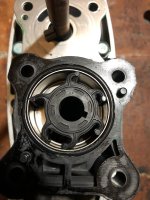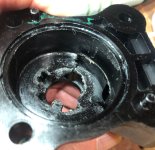BABJ1804689
9.9DK3SHC
Background: Previous owner purchased the engine new in 2015, started the break in procedure and realized he didn’t like the engine(too heavy and too fast) so he went back to his mid 70’s 2 stroke. His estimate was 5 engine hours. He claimed he started it about every 3 months or so replacing the fuel with fresh ethanol free premium fuel. He did not drain the carburetor or the fuel lines. The day I looked at it the temperature was well below 0C(32F) so we couldn’t get water to the engine, after looking over his shop and other equipment he owned I took a chance and bought the engine without hearing/seeing it run. The engine had been stored in a heated shop since new. About 2 weeks later the weather warmed to above 0C so I rigged it up with a barrel and started it up with some difficulty. First pull with choke on it sputtered, 2nd pull no choke sputtered, 3rd pull no choke no fire, 4th pull choke on sputter…. after the 12th pull it caught and ran. Tell tale has a strong flow. Let the engine warm up(10 min) Shut it off and restarted it a few times, one pull when warm, starts up no problem. Let the engine sit for an hour and it took 4 pulls to restart, no choke no start, 4th pull with choke started. Carb is now drained for the winter.
Ambient air temperature was 7C(44F)
Researching on this forum I believe it’s time for a carb cleaning even though the engine has 5 hours.
Service manual suggests I replace all carb o rings and the Carb gaskets and silencer gasket.
Do I really need to change out these parts with only 5 hours? I’ve been toying with the idea of trying a 2:1 ratio of fuel to Seafoam on a warm engine to see if I can clean the carb the lazy mans way. Thoughts?
Engine oil. Was wondering if I could finish breaking in the engine in with the OEM oil or should I replace the 7 year old oil with fresh oil? I plan on replacing oil and filter after break in(5 more hours) regardless.
Lower unit. Oil level good. Same question as engine oil?
Impeller is original but plan on changing it our sometime next summer. Tell tale is strong now.
We are in the dead of winter so nothing is going to happen except acquire the parts needed, closest Honda dealer is a 2 hour drive.
Any other suggestions?
Sorry for the long winded post but more information is better than not enough IMHO.
9.9DK3SHC
Background: Previous owner purchased the engine new in 2015, started the break in procedure and realized he didn’t like the engine(too heavy and too fast) so he went back to his mid 70’s 2 stroke. His estimate was 5 engine hours. He claimed he started it about every 3 months or so replacing the fuel with fresh ethanol free premium fuel. He did not drain the carburetor or the fuel lines. The day I looked at it the temperature was well below 0C(32F) so we couldn’t get water to the engine, after looking over his shop and other equipment he owned I took a chance and bought the engine without hearing/seeing it run. The engine had been stored in a heated shop since new. About 2 weeks later the weather warmed to above 0C so I rigged it up with a barrel and started it up with some difficulty. First pull with choke on it sputtered, 2nd pull no choke sputtered, 3rd pull no choke no fire, 4th pull choke on sputter…. after the 12th pull it caught and ran. Tell tale has a strong flow. Let the engine warm up(10 min) Shut it off and restarted it a few times, one pull when warm, starts up no problem. Let the engine sit for an hour and it took 4 pulls to restart, no choke no start, 4th pull with choke started. Carb is now drained for the winter.
Ambient air temperature was 7C(44F)
Researching on this forum I believe it’s time for a carb cleaning even though the engine has 5 hours.
Service manual suggests I replace all carb o rings and the Carb gaskets and silencer gasket.
Do I really need to change out these parts with only 5 hours? I’ve been toying with the idea of trying a 2:1 ratio of fuel to Seafoam on a warm engine to see if I can clean the carb the lazy mans way. Thoughts?
Engine oil. Was wondering if I could finish breaking in the engine in with the OEM oil or should I replace the 7 year old oil with fresh oil? I plan on replacing oil and filter after break in(5 more hours) regardless.
Lower unit. Oil level good. Same question as engine oil?
Impeller is original but plan on changing it our sometime next summer. Tell tale is strong now.
We are in the dead of winter so nothing is going to happen except acquire the parts needed, closest Honda dealer is a 2 hour drive.
Any other suggestions?
Sorry for the long winded post but more information is better than not enough IMHO.



